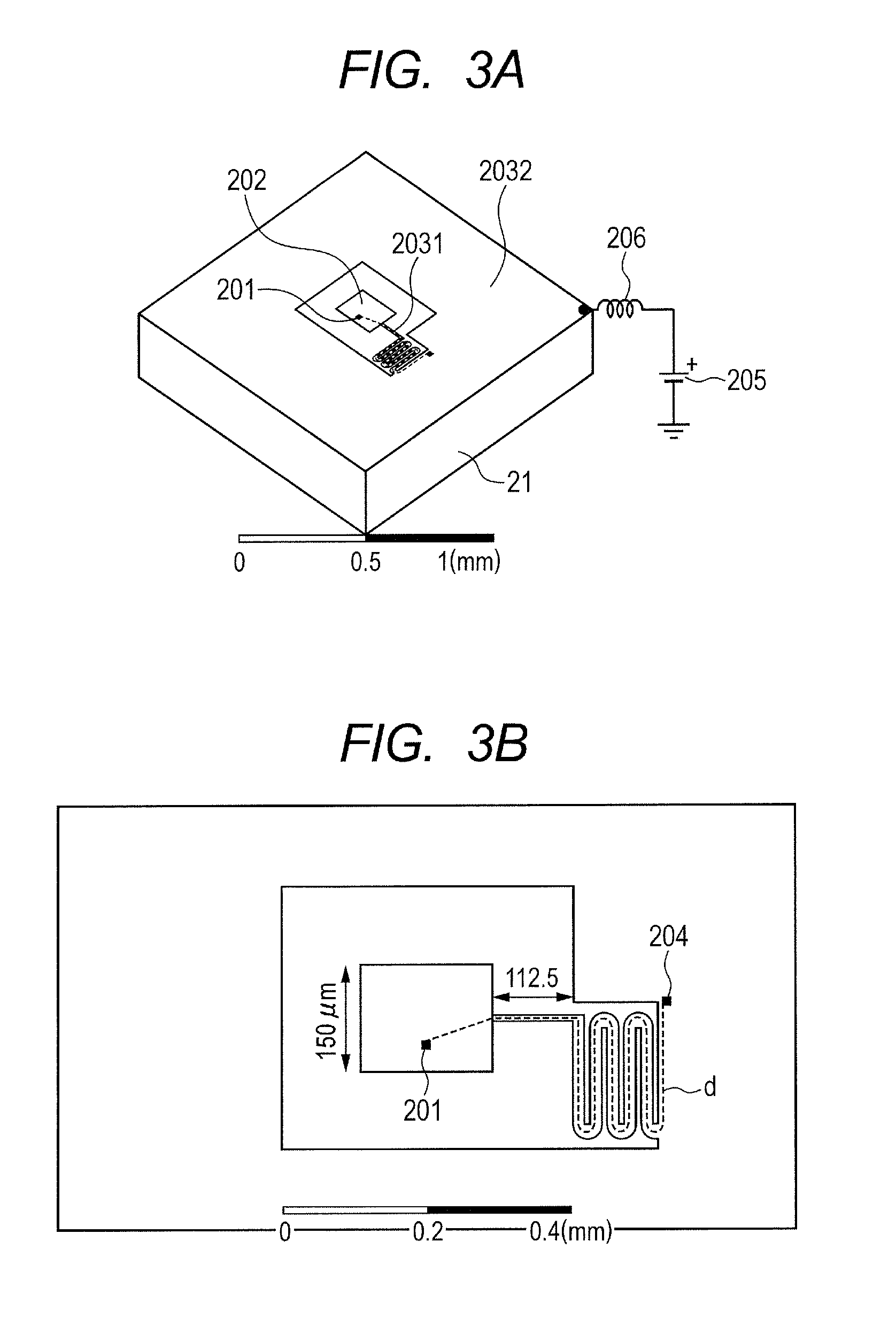Oscillator
- Summary
- Abstract
- Description
- Claims
- Application Information
AI Technical Summary
Benefits of technology
Problems solved by technology
Method used
Image
Examples
first embodiment
[0020]An oscillator according to a first embodiment of the present invention is now described with reference to FIGS. 1 and 2. FIG. 1 is a schematic diagram illustrating the oscillator of this embodiment. FIG. 2 is a circuit diagram illustrating the oscillator of this embodiment. In this embodiment, a resonant tunneling diode (RTD), an Esaki diode, or a Gunn diode is typically selected as a negative resistance device 101. Otherwise, a transistor having one terminated lead may be used. A resonator 102 for defining an oscillation frequency of an electromagnetic wave excited by the negative resistance device is a microstrip resonator using a patch antenna or a microstrip line with a finite length. The microstrip resonator refers to a resonator including an electrically floating conductive layer such as a metal plate connected to the ground. In FIG. 2 illustrating a corresponding equivalent circuit, devices are discriminated between the resonance circuit 102 for an oscillation frequency...
example 1
[0027]An oscillator according to Example 1 of the present invention is now described with reference to FIGS. 3A and 3B. FIG. 3A is a perspective view illustrating the oscillator of Example 1. FIG. 3B is a top view illustrating metal patterning in the vicinity of a patch antenna. In Example 1, a resonant tunneling diode (RTD) is used as a negative resistance device.
[0028]FIGS. 3A and 3B illustrate the patch antenna formed of metal patterning for electromagnetic wave oscillation and its peripheral circuit structure. The patch antenna of Example 1 is an oscillator for oscillating at approximately 0.5 THz. An RTD 201 includes, for example, a multiple quantum well structure of InGaAs / InAlAs and InGaAs / AlAs and electrical contact layers of n-InGaAs which are formed on an InP substrate 21. For example, a triple-barrier structure is used as the multiple quantum well structure. More specifically, a semiconductor multi-layer structure of AlAs (1.3 nm) / InGaAs (7.6 nm) / InAlAs (2.6 nm) / InGaAs (5...
example 2
[0033]An oscillator according to Example 2 of the present invention is now described with reference to FIGS. 4A and 4B. FIGS. 4A and 4B are diagrams illustrating an oscillator according to a modified example of Example 1, exemplifying the case where a resonant tunneling diode is used as a negative resistance device also in Example 2 and the oscillation frequency is high. FIG. 4A is a perspective view of the oscillator of Example 2. FIG. 4B is a top view illustrating metal patterning in the vicinity of a patch antenna.
[0034]The patch antenna of Example 2 is an oscillator for oscillating at approximately 0.9 THz. The details of the patterning are illustrated in FIG. 4B. A patch 302 is 75 μm in length on a side in the resonance direction. Taking into account the reactance of the RTD of 2 μm in diameter that is connected to the bottom of the patch 302, the oscillation frequency is approximately 0.9 THz. Even when the length of the side of the resonator is halved, the oscillation frequen...
PUM
 Login to View More
Login to View More Abstract
Description
Claims
Application Information
 Login to View More
Login to View More - R&D
- Intellectual Property
- Life Sciences
- Materials
- Tech Scout
- Unparalleled Data Quality
- Higher Quality Content
- 60% Fewer Hallucinations
Browse by: Latest US Patents, China's latest patents, Technical Efficacy Thesaurus, Application Domain, Technology Topic, Popular Technical Reports.
© 2025 PatSnap. All rights reserved.Legal|Privacy policy|Modern Slavery Act Transparency Statement|Sitemap|About US| Contact US: help@patsnap.com



